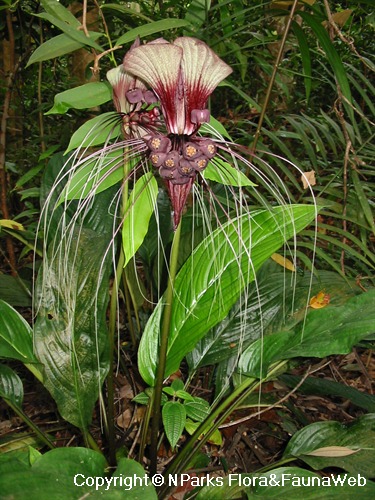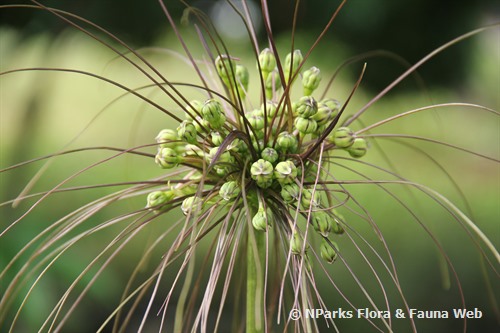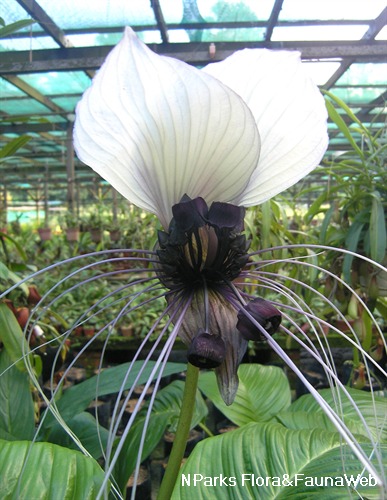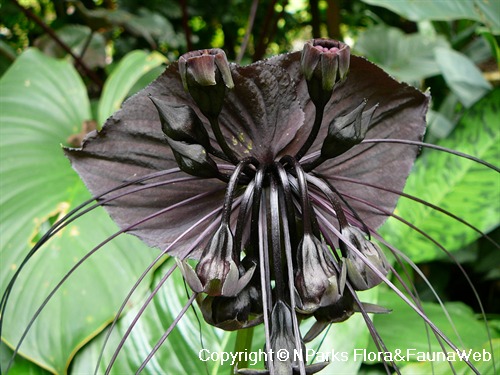
Back
Tacca chantrieri André
| Family Name: | Dioscoreaceae |
| Synonyms: | Schizocapsa breviscapa (Ostenf.) H.Limpr., Tacca esquirolii (H.Lév.) Rehder, Tacca garrettii Craib, Tacca macrantha H.Limpr., Tacca minor Ridl., Tacca roxburghii H.Limpr. |
| Common Name: | Black Bat Flower, Devil Flower, Cat's Whiskers |
Tacca chantieri, or known as Black Bat Flower, is a shade-loving herbaceous plant that can be found from Assam, China, through continental Southeast Asia. It produces bizarre inflorescences with purple to black wing-like bracts and long, whisker-like bracteoles. The plant can be grown in humid, shaded areas of parks and gardens.
Name
Classifications and Characteristics
| Plant Division | Angiosperms (Flowering Seed Plants) (Monocotyledon) |
|---|---|
| Plant Growth Form | Herbaceous Plant |
| Lifespan (in Singapore) | Perennial |
| Mode of Nutrition | Autotrophic |
| Maximum Height | 1 m |
Biogeography
| Native Distribution | India (Assam), Bangladesh, South-Central China (Yunnan, Guizhou), Southeast China (Guangxi, Guangdong), Hainan, Myanmar, Laos, Vietnam, Cambodia, Thailand, and northern Peninsular Malaysia |
|---|---|
| Native Habitat | Terrestrial (Primary Rainforest, Secondary Rainforest, Monsoon Forest) |
| Preferred Climate Zone | Tropical, Sub-Tropical / Monsoonal |
| Local Conservation Status | Non-native (Horticultural / Cultivated Only) |
Description and Ethnobotany
| Growth Form | It is a perennial, rhizomatous herb, growing up to 1 m tall. |
|---|---|
| Foliage | The leaves are fleshy and egg-shaped to oblong to lance-shaped, up to 17–55 cm long × 4.4–22 cm wide, with depressed veins. The upper surface of the leaves is deep green, while the undersides are paler. The petioles (leaf stalks) are 11-43 cm long × 2-5 mm wide. The leaves are arranged in a rosette. |
| Stems | It has vertical, cylindrical rhizomes (thick, horizontal, modified stems), usually underground but sometimes visible as the plant ages. |
| Flowers | The inflorescence is an umbellate cymose, subtended by two pairs of green to almost black involucral bracts: the outer pair is ovate, triangular to lance-shaped, pointing up and down respectively, and the inner, showier pair is broadly ovate to oblong, and pointing sideways. The bracteoles are thread-like, reaching 20 cm long. The flowers have six greenish-white tepals (a term for petals and sepals) that age to violet, purple or black, six purple stamens and a single tri-lobed stigma. Each flower is attached to a 1.2–4 cm long pedicel (a flower stalk). The inflorescences and flowers grow above the foliage. |
| Fruit | The fruit are ribbed obpyramidal berries, up to 4 cm long × 2 cm wide, that are either green, deep orange-red or purple, and contain numerous brown, kidney-shaped seeds. |
| Habitat | It can be found in primary and secondary forests, ranging from lowlands to hills in Peninsular Malaysia, up to 1400 (-2100) m above sea level elsewhere. |
| Associated Fauna | The flowers are predominantly autogamous (self-pollinating), although stingless bees (Trigona sp.) have been observed visiting the flowers and collecting pollen. <2> |
| Cultivation | It grows well in moist, shaded areas with moist but well-draining soil and plenty of organic material. It prefers high humidity due to its humid, understorey habitat. It can be propagated by seeds, rhizomes, or division. |
| Etymology | The genus Tacca is from a Malayan vernacular name, taka, 'arrowroot'. The specific epithet chantrieri is named in honour of Chantrier Frères, a nurserymen of Mortefontaine, France. |
| Ethnobotanical Uses | Edible Plant Parts : Edible Leaves, Edible Flowers Food (Fruit or Vegetable): In Thailand, the leaves and inflorescences are used in curries. Medicinal: In Thailand, the bitter rhizomes are used for medicinal purposes. |
Landscaping Features
| Landscaping | It is suitable for shaded to partially shaded, moist areas in parks and gardens. |
|---|---|
| Desirable Plant Features | Ornamental Flowers, Ornamental Foliage |
| Landscape Uses | Parks & Gardens, Small Gardens, Interiorscape/ Indoor Plant, Container Planting |
| Thematic Landscaping | Naturalistic Garden |
| Usage Hazard - Cons | Toxic Upon Ingestion |
| Usage Hazard - Cons Remarks | Toxic if ingested: The plant contains taccalonolides and, while not known to be toxic to humans, may cause an allergic reaction when ingested. It may be toxic to cats and dogs, so keep away from pets. |
Fauna, Pollination and Dispersal
| Pollination Method(s) | Abiotic (Self-Pollinated) |
|---|
Plant Care and Propagation
| Light Preference | Full Shade, Semi-Shade |
|---|---|
| Water Preference | Moderate Water, Occasional Misting |
| Plant Growth Rate | Moderate |
| Rootzone Tolerance | Moist Soils, Well-Drained Soils, Fertile Loamy Soils |
| Maintenance Requirements | Moderate |
| Pest(s) | Chewing Insects |
| Propagation Method | Seed, Storage Organ (Rhizome), Division |
Foliar
| Foliage Retention | Evergreen |
|---|---|
| Mature Foliage Colour(s) | Green |
| Mature Foliage Texture(s) | Smooth, Leathery, Raised / Sunken Veins |
| Foliar Modification | Flower/Fruit Bract |
| Foliar Type | Simple / Unifoliate |
| Foliar Arrangement Along Stem | Rosulate / Rosette |
| Foliar Attachment to Stem | Petiolate |
| Foliar Shape(s) | Non-Palm Foliage (Ovate, Obovate, Lanceolate, Elliptical, Oblong) |
| Foliar Venation | Pinnate / Net |
| Foliar Margin | Entire |
| Foliar Apex - Tip | Acute |
| Foliar Base | Cuneate, Attenuate |
| Leaf Area Index (LAI) for Green Plot Ratio | 3.5 (Shrub & Groundcover - Monocot) |
Non - Foliar and Storage
| Root Type | Underground (Fibrous Root) |
|---|---|
| Specialised Storage Organ(s) | Underground (Rhizome) |
Floral (Angiosperm)
| Flower & Plant Sexuality | Bisexual Flowers |
| Flower Colour(s) | Purple, Black, Green - Light Green |
|---|---|
| Flower Grouping | Cluster / Inflorescence |
| Flower Location | Axillary |
| Flower Symmetry | Bilateral |
| Ovule Placentation | Parietal |
| Ovary Position | Inferior / Epipgynous |
| Flowering Habit | Polycarpic |
| Inflorescence Type Remarks | Umbellate cymose |
Fruit, Seed and Spore
| Mature Fruit Colour(s) | Black, Orange, Purple, Red |
|---|---|
| Fruit Classification | Simple Fruit |
| Fruit Type | Fleshy Fruit , Berry |
| Mature Seed Colour(s) | Brown |
| Mature Seed Texture(s) | Ridged / Corrugated, Smooth |
| Seed Quantity Per Fruit | Numerous (>20) |
References
| References | <1> Drenth, E. (1976). Taccaceae. Flora Malesiana, Ser. 1, Seed Plants, Vol. 7: 806-819. <2>Zhang, L., Barrett, S.C.H., Gao, J-Y., Chen, J., Cole, W.W., Liu, Y., Bai, Z-L., & Li, Q-J. (2005). Predicting mating patterns from pollination syndromes: the case of “sapromyiophily” in Tacca chantrieri (Taccaceae). American Journal of Botany 92: 517–524. |
|---|
Image Repository
Others
| Master ID | 1196 |
|---|---|
| Species ID | 2489 |
| Flora Disclaimer | The information in this website has been compiled from reliable sources, such as reference works on medicinal plants. It is not a substitute for medical advice or treatment and NParks does not purport to provide any medical advice. Readers should always consult his/her physician before using or consuming a plant for medicinal purposes. |

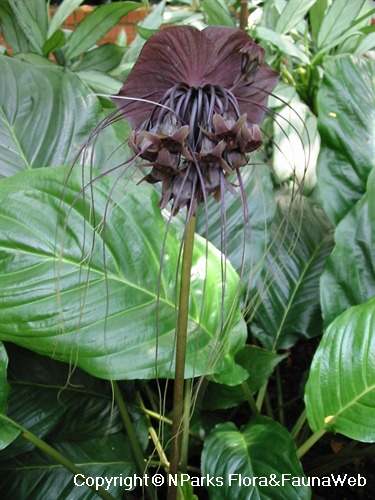
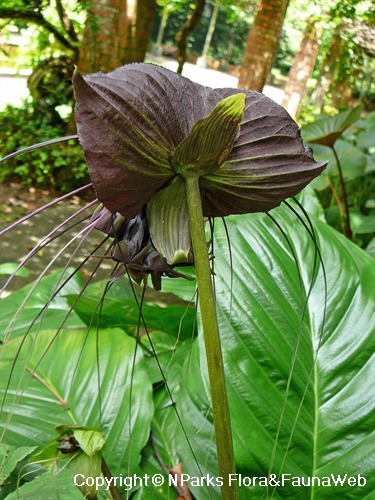
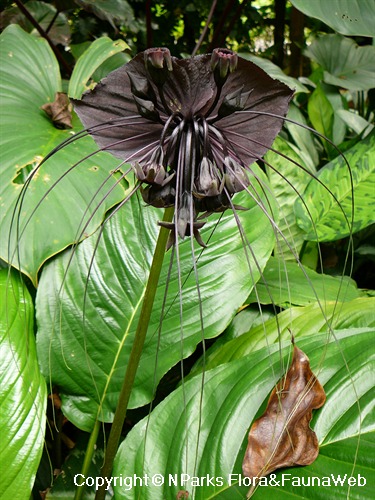
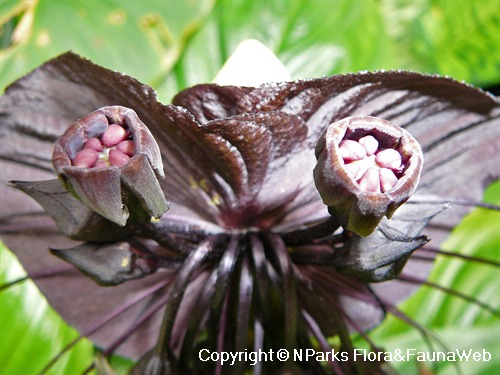
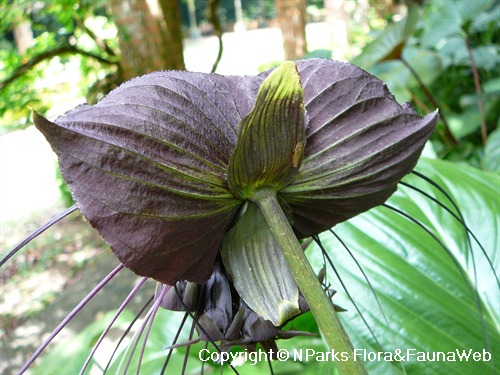
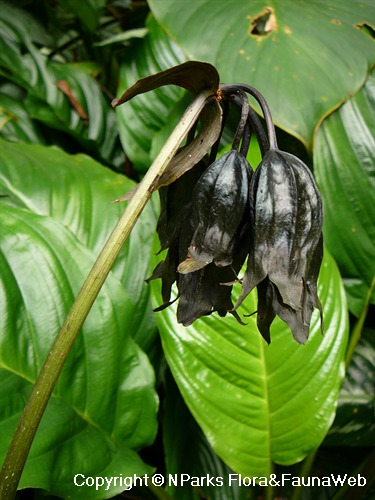
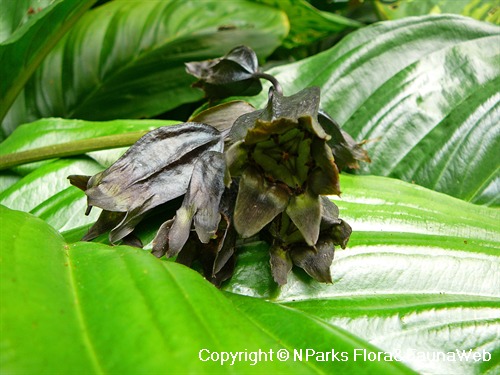
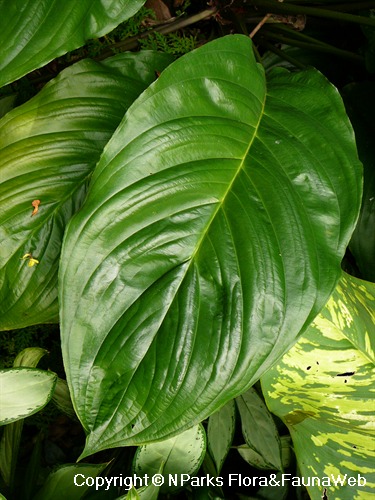
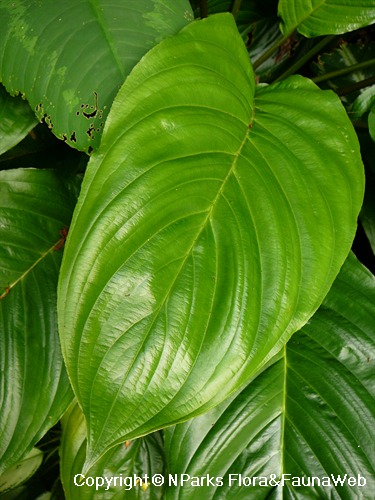
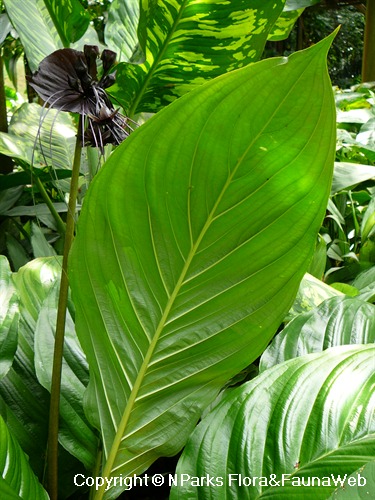
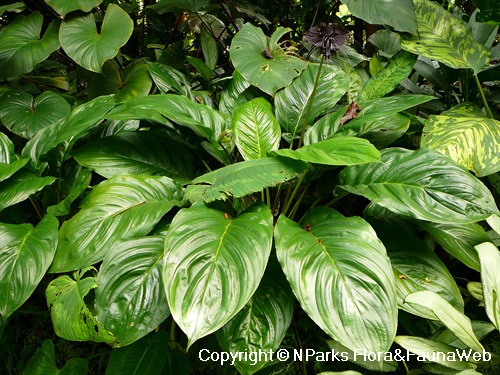
.jpg)
